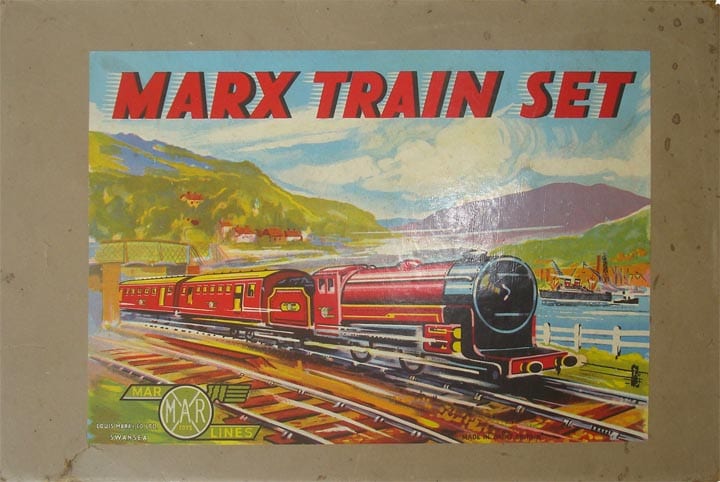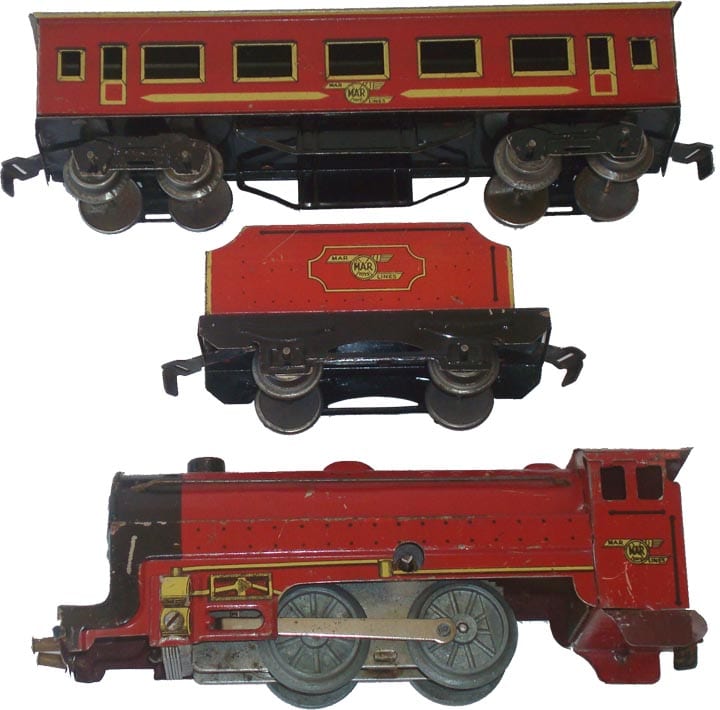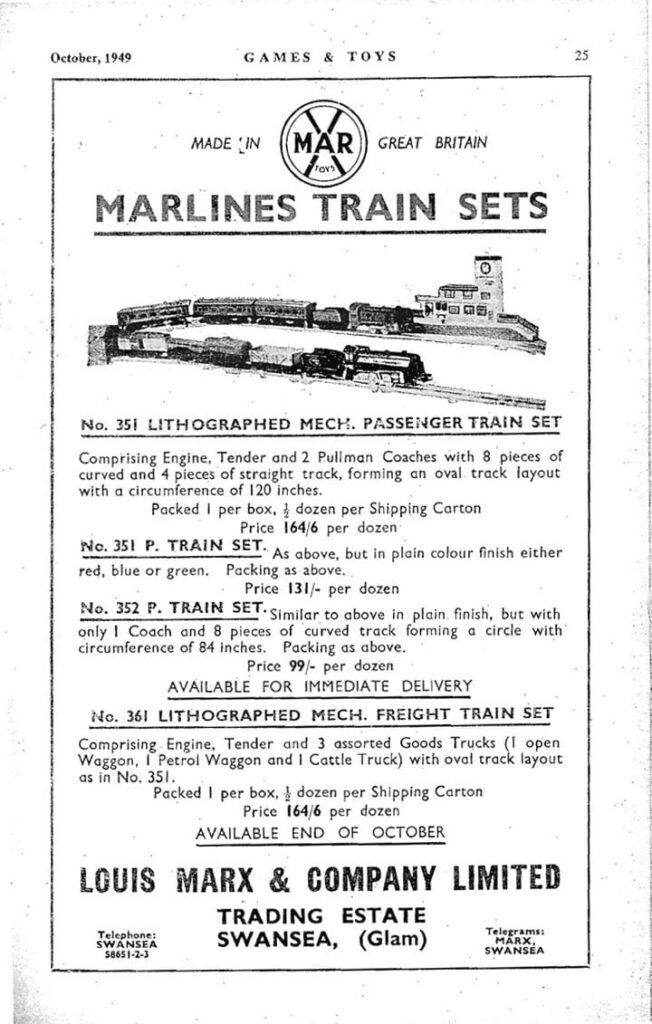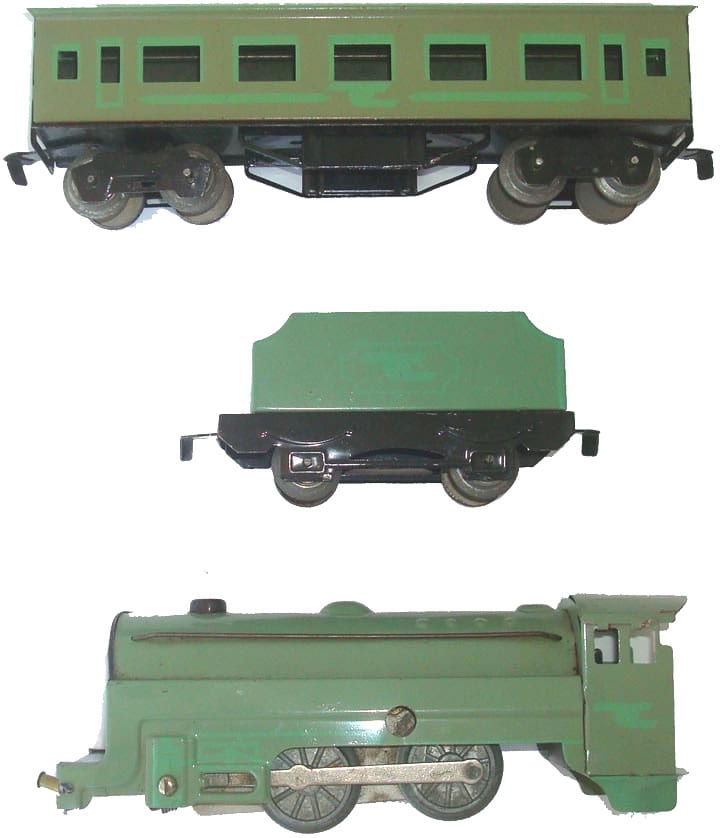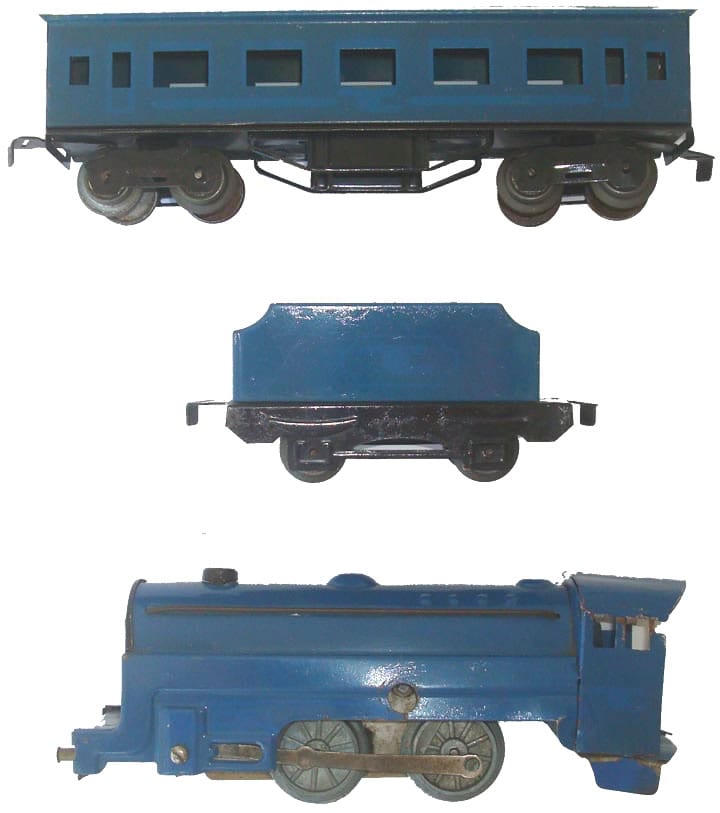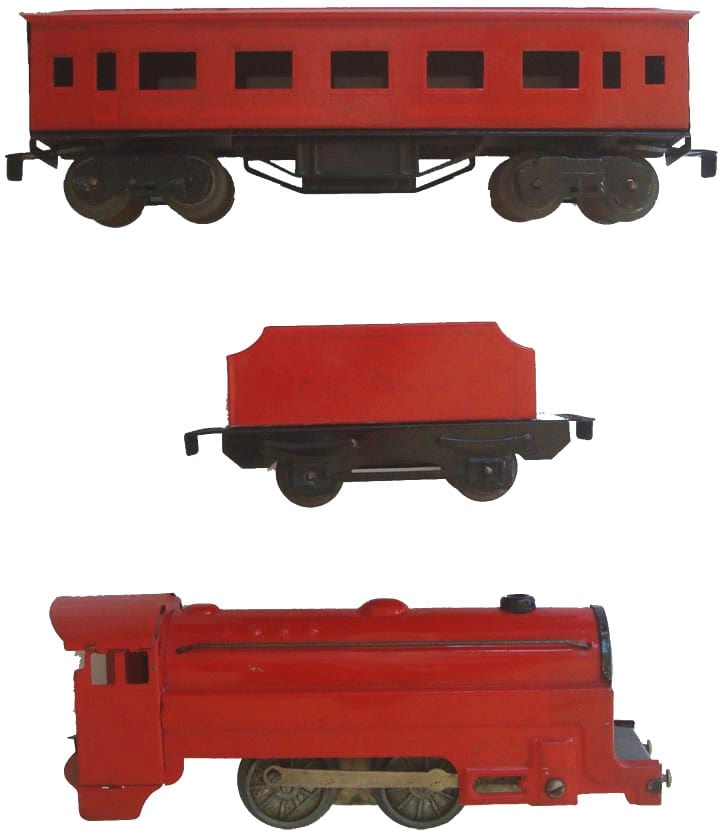British Marx Overpaint Sets – Making Lemonade from Lemons?
By Al Michelini
[email protected] Spring 2014
Certainly every seasoned TCA member has heard of Louis Marx and Co., but many collectors, including some Marx specialists, know little about Marx trains manufactured by Louis Marx & Co. Ltd. Trading Estate. British Marx, as opposed to English Marx made in Dudley, England, was manufactured in Swansea, Wales beginning around 1947 and continuing until the final demise in 1980.
This article will focus on a virtually unknown series of tinplate passenger sets produced in the early post war era.
Previous to this article, little had been written save a paragraph or so by the late Ian Paterson in the May 1997 Classic Toy Trains article entitled “Marx: Made in England” and by Paul Williams in his 2006 article for the Train Collector Society’s TCS News “BRITISH MARX — The O gauge tinplate toy trains: A Review.”
This will be the first opportunity to view the three color variations side by side. With all that said, let’s get to it. This article will detail the over-paint series of sets produced by Marx beginning sometime during 1948-1949.
So, you must be asking, “what is an over-paint set?” The simple description is that it is a clockwork passenger set consisting of an engine, tender and one or two passenger cars which have been painted on top of the lithography.
Excuse me, painted over top of the lithography? Why would anyone do that? Well that is a very good question and one that has yet to be answered by any surviving factory employees to date. However, a careful examination of the cars may lead to a reasonable guess for the production.
When the first examples surfaced about 18 years ago, many questioned the originality of the sets. Some believed the sets were a home-made modification, or even remanufactured by another company. However, we have since learned that these sets are factory production. Lithographed details can clearly be seen through the thin top coat of paint. Mint green was the first color to be found and described in articles and notes. The boiler front, smoke stack, coal pile and frames are black, while all other parts are painted green. The next color variation to be discovered was medium blue.
The engine, tender and coaches received the same treatment as the green variation, however, these were given a striking blue paint job. The final color variation to be found was red. As noted by a respected English Marx collector in England, the colors are an exact match to a series of die-cast trucks produced in Swansea by Marx. This practice of utilizing existing supplies across product lines was certainly common for Marx in the U.S. and the U.K. Regardless of overpaint color, all pieces observed had black boiler fronts, smoke stacks, tender coal piles and frames.
All sets appear to have originated as #351 mechanical red lithographed passenger sets.
The #351 red litho set is a very desirable and rare British Marx set in its own right. It was probably the first passenger set produced at the Swansea factory after it opened. The earliest reference to train production is an ad in the May 1947 British Industries Fair which included train sets in the description. Note: We have not seen this ad, but only found a description of the ad and the fair.
Since the #351 was the first passenger set produced, it is likely the one described. A later black and white advertisement from the 1949 British Industries Fair shows the #351 set available. The identification is made possible by the eye-catching lithographed details that are unique to this particular set. Later that year, an ad appeared in the trade publication Games and Toys on page 25 of the October 1949 issue.
Along with #351 set which is depicted in the ad, the ad mentions that 351P and 352P sets were available in red, blue, or green. The “P” referring to plain color. The 351P contained 2 passenger cars, and the 352P contained one passenger car. This is the only ad source mentioning plain color sets and it is believed that these are the overpaint sets.
None of the boxes examined contain any set numbers. From this research we can claim that the #351 was being produced at the same time as the overpaint 351P and 352P sets and the #351 production line could have been the donor of the litho sheet stock. There are several known variations of the red clockwork set. One variation has maroon frames on the passenger cars and another reported variation has more detailed boiler front lithography. Other variations involve short buffers versus long buffers, and the color of the passenger car ends. However, all the examined overpaint sets appear to have originated from the #351 red clockwork set with black frames.
Returning to the question of why these sets were overpainted, we will attempt to draw a conclusion from an examination of the available examples. Our research examined a total of 20 overpaint pieces including 4 green sets, 1 blue overpaint set plus one additional tender and 1 red overpaint set. Photos of additional overpaint sets were reviewed along with a number of #351 lithographed sets (5). Obviously, besides red, the #351 carries two distinct litho ink colors which are creamy yellow and black.
Eric J. Matzke in his Greenberg Guide to Marx Trains Volume 1 states on page 13 that the order of lithographic ink was first yellow, followed by red, then blue and finally black. The #351 set does not contain blue ink, so the order would have been yellow, red and finally black. We presume that this process was similar in both the U.S. and the U.K.
After examining several #351 sets, it appears that there are a number of flaws in the lithography that affect the overall appearance. Not being an expert in the lithography techniques of the late 1940s, I am unable to offer an opinion as to the exact cause of the imperfections, but never the less, they do exist on most #351 sets. Upon examination of the overpaint sets, the underlying details appear in various stages of completion.
For example, it is clear in both the green and blue sets that the lithographic process was not completed before the overspray of paint was applied. The black ink is not present in any of the green or blue pieces examined. However, the red and the yellow inks are quite visible through the thin layer of over spray.
The red overpaint set examined does appear to have the lithography completed in all 3 color inks prior to top coating with paint.
Most enthusiasts would find it absurd that the always cost-conscious Marx would allow a fully complete set to be repainted! So, why do it? Well, some have speculated that Marx was selling the sets abroad, possibly in Mexico, and wanted no identification on the trains. Another suggestion is that the sets were to be dumped at a discount store and they did not want the Marx name visible and associated with bargain basement items.
A quick examination of the set boxes certainly creates doubt on any supposition that suggests anonymity. All three boxes proudly display the same Marx name and label present on other British Marx sets of the period. The other possible explanation is that the litho sheets were rejected somewhere in the production process by quality control, and instead of reusing the sheets for something else, a commonly employed Marx factory procedure, the pieces were sent for over painting prior to forming.
Although it is difficult to see the flaws in the underlying litho, in some cases other types of flaws in production are quite evident. The most obvious ones are misalignment of the pattern on the stamped sheet. One can clearly see window and door outlines significantly off center from the openings, which may have been a cause for rejection.
Some other details of the examined sets provide possible clues to the history of this practice of over painting red sets. First, the red overpaint set box and the blue overpaint set box are quite similar to each other, and similar in construction to the common E-50 Streamline Speedway clockwork race car sets produced in the same factory just after W.W. II. The box is made from a thin, single ply, low grade cardboard probably necessitated by post wartime material or box production shortages in Great Britain.
These blue and red color variations are rarer than the green sets with only a couple of reported sets of each in existence. By contrast, one green set observed was in a better quality box, similar to later Swansea production blue 3978 passenger and freight set boxes. There are more known examples of the green overpaint sets than either the red or blue sets. One possible reason is that the practice continued to some degree with the green sets, after being discontinued in blue and red. After all, why have the equipment necessary for 3 different colors if it was only to make use of rejects. One color should have been sufficient once the lithographic process improved and the frequency of rejects diminished.
Also, production of the #351 sets ended about the time the British Rail style “Blood and Custard” coaches entered production sometime after the prototype debut in 1949. Since no known overpaint sets began life as Blood and Custard coaches, it is possible the lithography work was much improved and over painting was no longer necessary. It is also possible that early on, Marx encountered problems and an entire batch or at least a substantial number of lithographed sheets were subpar.
With such a large amount of poor quality or damaged stock, Marx may have made lemonade with their lemons and created the less expensive line of overpaint sets to quickly use up this poor inventory. That would explain the 1949 ad depicting both the regular #351 and the P series Overpaint sets simultaneously.
Unfortunately without any direct knowledge of the events in 1948-1950, we will only be able to suggest plausible answers to the question of the reason for the overpaint series. However, hopefully this article will prompt the dissemination of more information about these rare and intriguing sets.
The author invites owners of any overpaint pieces to compare their item with the results described here and submit details and photos. Also, any questions, comments or information about English or British Marx trains are welcome.

